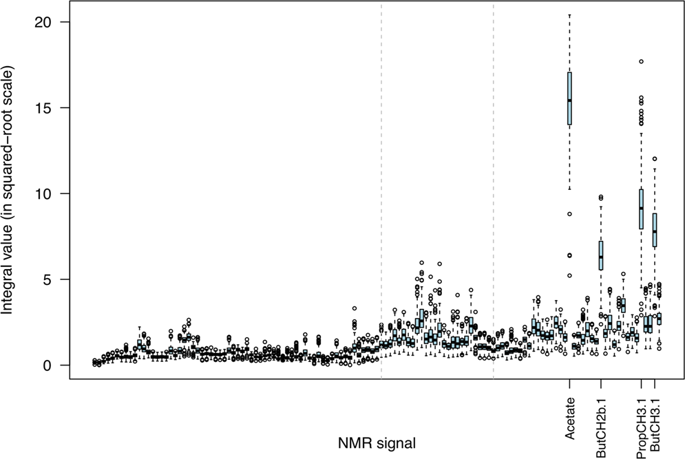Scientific Reports ( IF 3.8 ) Pub Date : 2020-03-27 , DOI: 10.1038/s41598-020-62485-y R Bica 1, 2, 3 , J Palarea-Albaladejo 4 , W Kew 5 , D Uhrin 5 , D Pacheco 3 , A Macrae 2 , R J Dewhurst 1

|
This study presents the application of metabolomics to evaluate changes in the rumen metabolites of beef cattle fed with three different diet types: forage-rich, mixed and concentrate-rich. Rumen fluid samples were analysed by 1H-NMR spectroscopy and the resulting spectra were used to characterise and compare metabolomic profiles between diet types and assess the potential for NMR metabolite signals to be used as proxies of methane emissions (CH4 in g/kg DMI). The dataset available consisted of 128 measurements taken from 4 experiments with CH4 measurements taken in respiration chambers. Predictive modelling of CH4 was conducted by partial least squares (PLS) regression, fitting calibration models either using metabolite signals only as predictors or using metabolite signals as well as other diet and animal covariates (DMI, ME, weight, BW0.75, DMI/BW0.75). Cross-validated R2 were 0.57 and 0.70 for the two models respectively. The cattle offered the concentrate-rich diet showed increases in alanine, valerate, propionate, glucose, tyrosine, proline and isoleucine. Lower methane yield was associated with the concentrate-rich diet (p < 0.001). The results provided new insight into the relationship between rumen metabolites, CH4 production and diets, as well as showing that metabolites alone have an acceptable association with the variation in CH4 production from beef cattle.
中文翻译:

核磁共振检测与牛牛肠甲烷排放相关的瘤胃代谢产物。
这项研究提出了代谢组学在评估饲喂三种不同日粮类型的牛肉牛的瘤胃代谢物变化方面的应用:饲草,混合和浓缩。通过1 H-NMR光谱分析瘤胃液样品,所得光谱用于表征和比较饮食类型之间的代谢组学特征,并评估NMR代谢物信号用作甲烷排放代理的可能性(CH 4单位为g / kg DMI) )。可用的数据集包括从4个实验中获得的128个测量值以及在呼吸室中进行的CH 4测量值。CH 4的预测建模通过偏最小二乘(PLS)回归进行,拟合模型仅使用代谢物信号作为预测指标,或者使用代谢物信号以及其他饮食和动物协变量(DMI,ME,体重,BW 0.75,DMI / BW 0.75)进行拟合。两种模型的交叉验证的R 2分别为0.57和0.70。提供高浓缩饮食的牛显示丙氨酸,戊酸,丙酸,葡萄糖,酪氨酸,脯氨酸和异亮氨酸含量增加。较低的甲烷产量与富含浓缩物的饮食有关(p <0.001)。结果为瘤胃代谢物,CH 4的产生与饮食之间的关系提供了新的见解,并表明仅代谢物与CH的变化之间存在可接受的关联4肉牛生产。









































 京公网安备 11010802027423号
京公网安备 11010802027423号